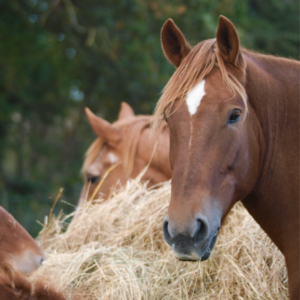 Equine Gastric Ulcer Syndrome: Dietary Management. According to the American Association of Equine Practitioners, approximately 93% of racehorses, 60% or more of performance horses, and 25-50% of foals have or have had equine gastric ulcer syndrome.
Equine Gastric Ulcer Syndrome: Dietary Management. According to the American Association of Equine Practitioners, approximately 93% of racehorses, 60% or more of performance horses, and 25-50% of foals have or have had equine gastric ulcer syndrome.
Understanding the Inner Workings:
The horse’s stomach is divided into two distinct regions. The upper, nonglandular portion is covered with thin epithelial, or squamous, cells. This portion has little protection from stomach acid.
The dividing line between the upper and lower regions of the stomach is known as the margo plicatus and is the most common site of nonglandular ulcers.
The lower, glandular region is where acid is secreted, and it has a protective coating to prevent damage from acid. While ulcers can occur in the lower portion of the stomach, the cause is usually from long-term use of nonsteroidal anti-inflammatory drugs. These ulcers are less common than those that occur in the upper portion of the stomach.
Risk Factors:
Risk factors for EGUS include stall confinement, no access to hay or forage for longer than four to six hours, high-grain diets, stress, and exercise.
Signs of ulcers may include lack of appetite, colic symptoms, weight loss, poor performance, girthiness, or any general change in attitude or behavior. Some horses show signs while others are more stoic.
Management:
While the only FDA-approved medication for the resolution of ulcers is omeprazole, there are ways to help manage the condition through diet.
“For starters, make sure your horse does not go without hay or forage for more than a few hours. A ‘slow-feeder’ haynet can be a useful tool to extend the time it takes a horse to consume hay,” explained Kathleen Crandell, Ph.D., a nutritionist with Kentucky Equine Research.
Hay:
If possible, offer the horse some alfalfa hay or alfalfa-based forage product, as alfalfa typically contains more calcium than grass hays, and calcium serves as a buffer for stomach acid. If the horse consumes a concentrate, look for a product that is low to moderate in starch and sugar, advised Crandell. Feeding starch in excess of 2 grams per kilogram of body weight increases the risk of ulcers, according to some studies.* Most nutritionists consider low to moderate starch and sugar between 12-20%.
When getting ready to exercise a horse, allow him to consume some hay (about a pound) prior to riding. The ingested forage creates a “mat” that sits on top of gastric juices and reduces the natural splashing of acid that occurs with movement and exercise.
When it comes to supplements, very few are backed by research.
In conclusion, when it comes to gastric ulcers, every horse is at risk. Both environmental and dietary management are key for minimizing occurrence.
Resources:
If you have questions about Equine Gastric Ulcer Syndrome: Dietary Management, contact J & J Hay Farms today at 770-887-0440!
*Sykes, B.W., M. Hewetson, R.J. Hepburn, N. Luthersson, and Y. Tamzali. 2015. European College of Equine Internal Medicine Consensus Statement – Equine Gastric Ulcer Syndrome in Adult Horses. Journal of Veterinary Internal Medicine 29(5):1288-1299.
